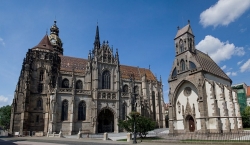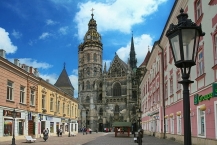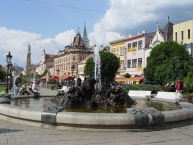Cycle Tour Zenit-Reise
Travel report: rund um und in den Karpaten
Actions
![]()
Please wait - map data are loading
Added on 06 Jul 2014,
on 24 Nov 2019
Actions
Cycle route metrics
planned
ridden
Total distance in km
2.246
0
Cumulative elevation gain in m
20.955
0
Avg. slope uphill in %
0,93
-
Cumulative elevation loss in m
20.943
0
Information about rights to the gps-track data | |
|---|---|
Rights owner | |
Rights characteristic / license | by-sa: CREATIVE COMMONS Attribution-ShareAlike |
Link to the description of the license | |
GPX file uploaded | by EbsEls on 06 Jul 2014
|
Track points in total
13.826
0
Track points per km (avg)
6
0
Start/endpoint
Start location
okres Košice I, Košický kraj, SK (205 m NHN)
End location
Alba Iulia, RO (217 m NHN)
Character
2011 sollte es nach Georgien gehen ... gekommen bin ich bis nach Odessa. Eine große und erlebnisreiche Tour war es trotzdem.
Information about copyright | |
|---|---|
Rights characteristic / license | by-sa: CREATIVE COMMONS Attribution-ShareAlike |
Link to the description of the license | |
taken over / edited on | 06 Jul 2014
|
taken over / edited by |
|
Beds4Cyclists, worth visiting and infrastructure
Name and address
Latitude / Longitude
Phone
Fax
Mobile
Type of accommodation
Rating for cyclists
Route km
Dist. to route
Elevation
0 km
0,8 km
215 m
0 km
0,4 km
217 m
0 km
0,8 km
213 m
0 km
0,6 km
218 m
Services without charges
are information about:
- the actual news
- companies
- services
- offices
- accommodation possibilities
- catering possibilities
- recreation possibilities
- transportation
- events
- in the town
- in the region
- even abroad
Information about copyright | |
|---|---|
Rights characteristic / license | by-sa: CREATIVE COMMONS Attribution-ShareAlike |
Link to the description of the license | |
taken over / edited on | 28 Jan 2016
|
taken over / edited by |
|
Hours of opening
Monday - Friday: 9.30 - 18:30
Saturday: 10.00 - 15.00
0 km
0,6 km



Košice (pronounced [ˈkoʃitse]) is the second largest city in Slovakia, with a population of over 250,000. It has been selected the European Capital of Culture for the year of 2013.
Understand
Košice has had a colourful history with its ever changing medieval and modern rulers of Hungarians, these days hardly imaginable Turks for a while, Czechs and nowadays Slovaks. Serving its part as a center of what may best be described as a frontier of Slovak hill country, Hungarian lowlands and Ukrainian/Russian/Soviet East, it has become a predominantly Slovak city in what was then Czechoslovakia after its emergence in chaos of reconciliations after the First World War. Until these days the city is inhabited by descendants of east Slovak dwellers with many relations in the gorgeous rural surroundings of the city who were flocking to the town during its industrial boom after the WW2 and a large Hungarian speaking minority along with its fast growing underprivileged and often resented population of Gypsies (or Romas as is their official naming). A smart, patient and crying with the wolves traveller may find the city suffer from what may best be described as a small man syndrome, a feeling shared by many locals probably best attributed to being the second city in Slovakia and a place not often visited from elsewhere. This may however help in engaging with many residents who may seem to be one of those lovely people who actually enjoy foreigners visiting their place. The city prides on being known as "The City of Peace" thanks to non-violent ethnic and national tolerance throughout its history. Despite its relative remoteness, you may likely find Košice a hidden, unknown and approachable gem when seeking for a lesson in less known European history, lively arts scene or for a less spiritual entertainment thanks to its vibrant party scene.
History
The area around Košice has been inhabited since the 8th century, but it was in the 13th century that it developed into a town. It grew relatively rich during the Middle Ages due to its strategic position as a trading center. Having briefly served as the capital of the liberated Czechoslovakia after World War II, it is now finding its new role as one of the easternmost centers of the new European Union. It provides a look into the not-that-long-gone way of living in an eastern European country while also serving as a lovely example of a booming and rapidly changing place with rich ancient history best served by its stunning historic city center, with an impressive cathedral quickening the hear-beat of every picture hunting traveller.
See
Most of Košice's attractions are along the main pedestrianized street, known as Hlavná ulica (Main Street), Námestie Maratónu Mieru (Peace Marathon Square, the north end of Hlavna), and Námestie Osloboditeľov (Square of the liberators, at the southern end of Hlavna) at various parts.
- Main Street (Hlavná ulica) where most of the sights worth seeing are. With its unique atmosphere it creates the heart of the town. In the past, it used to be a medieval square and the whole town started to grow from this point. Now this place is flat, however in the past it used to be hilly and even a stream flew there. The "Čermeľský potok" (The Tshermel stream) used to create an island on the main street, where the Saint Elizabeth cathedral is located now. Due to developing infrastructure, this stream has been landed up in 1899 and was renewed only symbolically during the renovation of the main street in the 1990s. Today, all the traffic from the main street is excluded, therefore it is a very pleasant pedestrian site. Except the Saint Elizabeth Cathedral, you will find also the Saint Michael Chapel, Urban tower, The State Theater, the so-called singing fountain (a unique fountain in Europe), as well as many stylish original bourgeois houses.
- ⊙St Elizabeth's Cathedral (Dóm sv.Alžbety). This remarkable medieval monument was built in the High Gothic style. The present cathedral stands on a site formerly occupied by a parish church, which was destroyed by fire around year 1370. The patrons of the church included St. Elizabeth. The construction of St. Elizabeth's Cathedral began approximately in 1378. The entrance to the cathedral is for free anytime during the day. There is also a possibility to visit the northern tower of the cathedral, which gives you a stunning view of the surrounding historical centre. The height of this tower is 59.7m and contains 160 stairs in the staircase. It is open all year long between 10am and 17pm. You can buy the tickets at the entrance to the cathedral. The entrance fee is rather cheap.
- ⊙St. Michael's Chapel (Kaplnka sv.Michala). The chapel probably comes from the first half of the14th century and had always been a part of the parish church. It was built as a cemetery chapel in the centre of a cemetery inside the city walls stretching from the Cathedral to the South on the island of the Čermeľský potok (Čermeľ brook) in the place of the present park in the Hlavná ulica (Main street). The outer decoration is Gothic, the turret is fitted in the roof structure. The patron of the dead, the Archangel Michael, vanquishing the Satan as dragon is shown on the altar. There are Archangels Rafael and Gabriel on his sides. In the interior, there is a nice stone tabernacle, the ornamental sculpture "Ecce Homo" and remains of wall paintings from Middle Ages. The oldest coat-of-arms of Košice is situated above the door leading to the vestry.
- ⊙Saint Urban's tower (Urbanova veža). Originally a Gothic prismatic campanile with a pyramidal roof dating back to the turn of the 14th and 15th centuries. The bell, which was installed in the tower (its weight equals to 7 tones), was dedicated to St. Urban, the patron of wine-prowers, which was cast in a mould by the bell founder Frantisek Illenfeld of Olomouc in 1557. 36 tombstones dating from the 14th century (one of these tombstones is Roman dating from the 4th century) to the 17th century were put into the outer walls of the Tower. In 1966 the Tower was damaged by fire, which destroyed the roofing and the bells. In the years 1967-1971 the Tower was subjected to restoration and renovation.
- ⊙The State Theatre (Štátne divadlo). The theatre was built in a new-baroque style during the years 1879-1899, according to the projects of A. Lang and A. Steinhardt, where a former theatre building, built in 1788 - 1790, was situated. Originally before that a town-hall building was standing here. The interior of theatre is richly decorated with plaster ornaments, the stage is lyre-shaped. The ceiling of the theatre's building is decorated with paintings by the Viennese painter P. Gatseb with scenes from Shakespeare's tragedies Othello, Romeo and Juliet, King Lear and Midsummer Night's dream. On the main forcade of the building a memorial plaque can be found, dedicated to the first director of the theatre after WW2 - the national artist Janko Borodac.
- ⊙Immaculata (Plague Column). The Immaculata Statue is the most beautiful Baroque-style sculptured monument in the City. It commemorates the plague from the years 1710 -1711 and is dated from 1720 - 1723. It is a 14 m high column on the stone base with sculptures of Josef, Sebastian and Ladislav. On the top there is the sculpture of Virgin Mary. On the pillars of the fence there are sculptures of St. Gabriel, St. Elizabeth of Hungary, St. Margita, St. Michael the archangel and St. Barbora.
- Palaces of Košice. Košice is the city which has the highest number of palaces in Slovakia and all of them are worth seeing. Perhaps the most important palace is the ⊙Former Town Hall (Stará radnica), which is the oldest of Košice's council offices. ⊙The Andrassy's Palace (Andrášiho palác) today serves as the biggest cafeteria and patisserie - AIDA. The other palaces include ⊙The Bishop's Palace (Arcibiskupský palác), ⊙Hadik - Barkoczy Palace (Hadík - Barkócziho palác), ⊙Pongrácz - Forgács' Palace (Pongrácovsko - Forgáčovský palác) - the seat of the Regional State Library and ⊙Csáky - Dessewffy Palace (Csáky - Dezőfiho palác) - at present the building is the seat of the Constitutional Court of Slovak Republic and at the same time it is the so-called 'palace of the books' as you can find the biggest bookstore of Košice, selling books not only in Slovak, but also in Hungarian, English, German and other languages. We shall not to forget about the ⊙Captain's Palace where you can find the Slovak Technical museum and last but not least, ⊙Jacab's Palace (Jakab-palota Jakabov Palác) which was erected in 1899 in the pseudo-Gothic style constructed from discarded stones from the Kosice St. Elizabeth's Cathedral and most of the inhabitants of Košice would choose this building as one of the most beautiful ones.
- ⊙Beggar's House (Žobrákov dom) - For an interesting story you may look up the Beggar's House which is one of the historical houses on Hlavna (on the right between the Theater and Immaculata when walking up north). On forefront, at top of the house you will see a statue of a guy with a hat thanking/begging for alms. The story says the career beggar who had no other income had over years used generosity of rich Košice dwellers to build the house at what was then a very 'high-end' medieval (a.k.a. Hlavna Street) part of Košice. This kind of largess may seem to be perceived a bit strange by today's beggars rarely appreciating Košice inhabitants, but it still makes up for a good narrative. And a historic house.
Museums and galleries
- ⊙East Slovak Museum (Vychodoslovenske muzeum) was established in 1872 and it is one of the oldest and most significant museums in Slovakia. From the architectonic point of view, the buildings of the museum itself are very interesting historical sights. In this museum, the following permanent expositions can be found: the nature of Carpathia, Hundreds of years of art, "Rodosto" - the memorial house of Franz II. Rakoczy, Artistic metal founding in Eastern Slovakia and Centuries of Košice - Mikluš's Prison. Except these expositions, there are always some temporary events and expositions.
- ⊙Muzeum Vojtecha Lofflera, 20 Alzbetina ulica. Likely interesting for the more art inclined traveler after seeing the usual government sponsored touristy stuff.
- ⊙Lower gate (Dolná brána),Hlavná. The Dolná brána is so named for the underground museum complex with original gateway to the city and parts of the original town fortifications, which were established in the 2nd half of the 13th century. They were uncovered when the main street Hlavná street was being reconstructed in 1996.
Do
- Walking the historic center. The best thing to do on a short trip or shortly after arriving is to walk the compact and lovely historic center.
Information about copyright | |
|---|---|
Rights characteristic / license | by-sa: CREATIVE COMMONS Attribution-ShareAlike |
Link to the description of the license | |
Input taken over from: |
Wikivoyage contributors, 'Košice', Wikivoyage, The FREE worldwide travel guide that anyone can edit, 7 May 2016, 00:36 UTC, <https://en.wikivoyage.org/w/index.php?title=Ko%C5%A1ice&oldid=2987724> [accessed 29 August 2016] |
taken over / edited on | 06 Dec 2015 - 29 Aug 2016
|
taken over / edited by |
|
![]()
